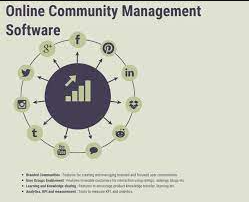Social media community management

social media community management
It’s no longer enough to simply post content and hope for engagement. In today’s hyper-connected world, effective social media community management is key to building brand loyalty and driving business success. But what exactly is social media community management? And how can you ensure your strategy is delivering results? In this blog post, we’ll explore the benefits of social media community management, share best practices for success, and provide tips on measuring the effectiveness of your efforts. So let’s dive in!
Defining Social Media Community Management
Social media community management refers to the practice of building, growing, and engaging a community around your brand on social media platforms. This involves creating content that resonates with your target audience, responding to comments and messages in a timely manner, and fostering meaningful conversations.
At its core, social media community management is about relationship-building. By interacting with your followers in a genuine way, you can cultivate a sense of trust and loyalty that translates into increased engagement and sales.
Effective social media community management requires understanding your target audience intimately. You need to know what they care about, what motivates them to engage with brands on social media, and how they prefer to communicate.
One key aspect of successful social media community management is consistency. This means having a clear posting schedule for each platform you use so that users know when to expect new content from you. It also means ensuring that all interactions are handled professionally and consistently across all channels.
Ultimately, the goal of social media community management is not just to boost likes or followers – it’s about building lasting relationships with people who believe in your brand’s values and mission.
The Benefits of Social Media Community Management
Social media community management provides numerous benefits for businesses and brands. One of the main advantages is that it allows companies to build a strong online presence. By creating engaging content, responding promptly to comments and messages, and cultivating a loyal following, businesses can establish themselves as thought leaders in their industry.
Another benefit of social media community management is increased brand awareness. Social media platforms offer an excellent opportunity for businesses to reach new audiences through shares and retweets. When followers share your posts or tag friends in the comments section, it helps to expand your reach beyond your current audience.
Social media community management also enables businesses to gather valuable insights about their target audience. By monitoring conversations on social media platforms, you can gain insight into what people are saying about your brand, products or services – allowing you to make informed decisions about future marketing campaigns.
Furthermore, effective social media community improves customer satisfaction by providing timely responses to queries and concerns raised by customers on social media . This helps develop trust with customers who will appreciate being heard by the company they purchase from.
Social media community enhances SEO efforts by driving traffic back to a business’s website through well-placed links within posts.
This leads not only more traffic but also better rankings on search engines such as Google.
Measuring the Success of Your Social Community Management Strategy
Measuring the success of your media community management strategy is crucial to determine if you are achieving your goals or not. There are different metrics that you can use to measure the effectiveness of your strategy, such as engagement rates, reach, and conversion rates.
One way to measure engagement is by looking at the number of likes, comments, shares and reactions on your posts. High engagement means that people are interested in what you’re sharing and they find it engaging enough to interact with.
Another metric that matters is reach. Reach refers to how many people have seen your content. This metric helps you understand whether or not you’re reaching a wider audience and increasing brand awareness on social media platforms.
Conversion rate measures how many users take desired actions after seeing one of your posts such as clicking through links or signing up for a newsletter.
By measuring these metrics regularly over time can help identify areas where improvement may needed while give insight into what’s working well so adjustments can be made accordingly for future campaigns.
Best Practices for Media Management
Best practices for social media management involve creating a strategy that aligns with your brand’s values and goals. It’s important to establish guidelines for your team members to ensure consistency in messaging and tone across all platforms.
Another best practice is to create content that adds value and encourages conversation among followers. Ask questions, share relevant industry news, or run contests to encourage engagement.
Don’t forget the importance of being authentic on social media. Your audience wants to connect with real people behind the brand – avoid overly promotional posts and focus on building genuine relationships with followers through meaningful interactions.
Conclusion
In today’s digital age, social management is crucial for any business or brand that wants to succeed in the online world. It allows you to connect with your audience on a personal level, build relationships and establish trust. With effective community management strategies, you can achieve high engagement rates, increased brand awareness and ultimately drive conversions.
So if you looking to take your media presence to the next level, consider investing in a solid community strategy – it might just the key ingredient needed for success!




